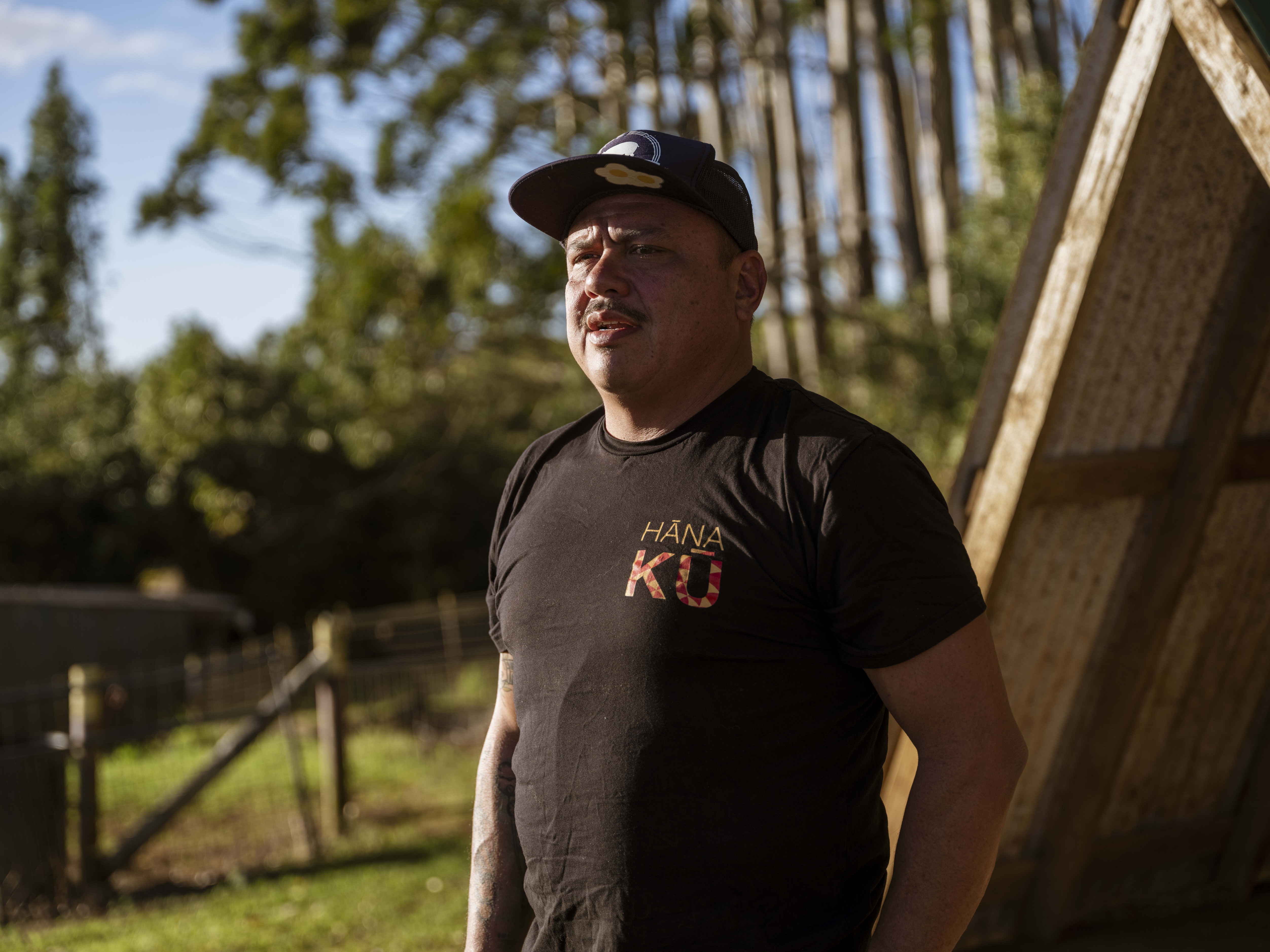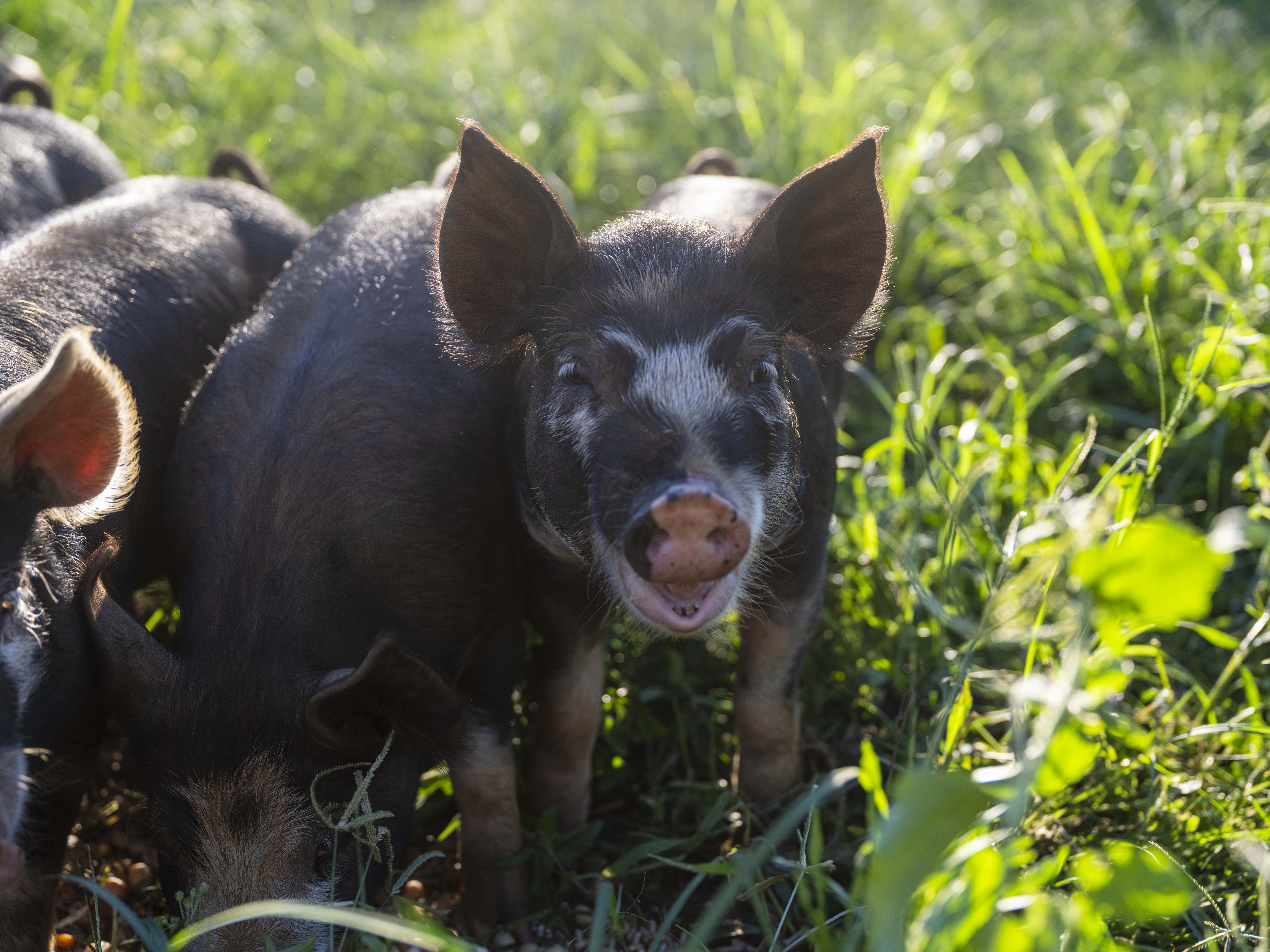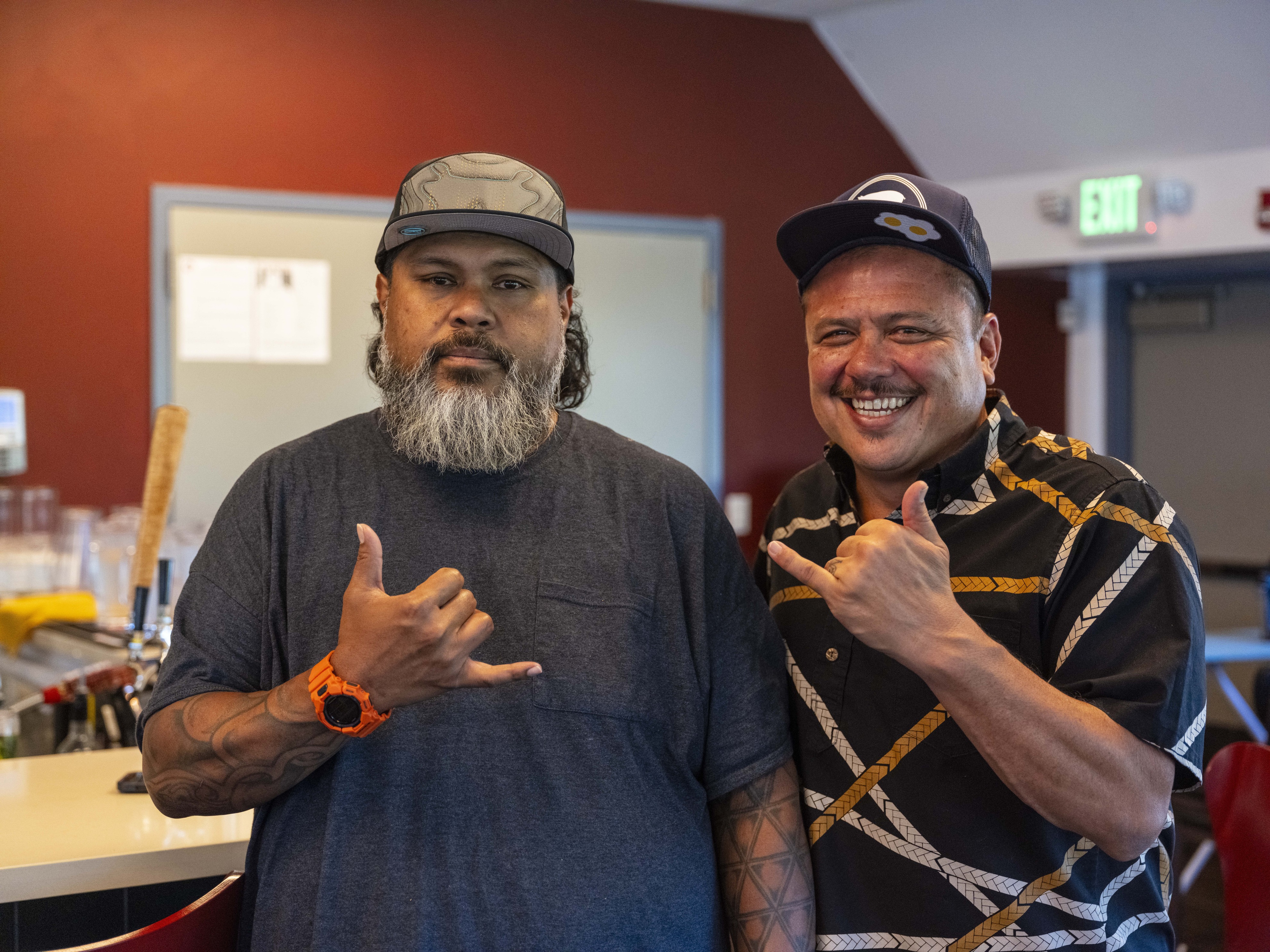
Honoring Tradition: Hawaiian Embraces Sustainable Pig Farming to Help Preserve Cultural Heritage
To meet farmer and restauranteur Brandon Lee is to meet a man who embodies the spirit of his native Hawaiian Islands, capturing the essence of the tropical paradise, as well as a deep connection to the land he calls home. From the way he cares for his land, to the meals he serves, Lee invites visitors to savor a taste of Hawaii—alive in every ingredient.
“We have a responsibility being from Hawaii to be a certain type of person, really aloha, really welcoming, really open to everything, and happy,” said Lee. “And you have a responsibility to highlight Hawaii as accurately as possible.”
Highlighting Hawaii is what Lee tries to do at both his pig farm, Kaunamano Farm and his restaurants, Lehua and Napua at Mauna Lani Beach Club, all on the big island of Hawaii. But he also tries to highlight sustainability, resiliency and most important to Lee: the core value of maintaining balance and preserving resources for future generations to enjoy in Hawaii.

“That's why you choose farm to table. You're going to go the extra step because those things aren't just a good idea, it's also good for the community. It's good for the soil, it's good for the humans that work with you. You know, it's good for the whole ecosystem in general, right?” Lee said. “And that's what you're supposed to be paying attention to here in Hawaii.”
Being mindful of the natural resources that they’ve been entrusted with is what is naturally engrained into a farmer’s soul, and this is especially true in a place like Hawaii. Living on an island highlights the limited availability of essential resources like land, water, and energy. While some may see those as obstacles to overcome, Lee sees them us lessons that can teach us about ingenuity and resourcefulness. Protecting natural resources and rebuilding the agricultural identity of Hawaii is why Lee set out to be a farmer.
Taking the Leap: First-Time Farmer Embarks on Agricultural Journey
Born and raised in Hawaii, agriculture wasn’t Lee’s first career path. He graduated with a degree in marketing, and for a time that’s what he was doing in Los Angeles. That chapter of his life helped him to understand just how deep his connection to his homeland of Hawaii was.
“I think the experience of spending a couple of years in the mainland to have that contrast of what other life is like, because sometimes you're here in Hawaii and it's so beautiful all the time and you just don't even realize how good you got it,” Lee said. “So, after you realize how beautiful it is, you really want to cherish it.”
Lee knew he wanted to come home and celebrate his homeland, but he also wanted others to do the same, and that’s when the idea of raising pigs came up, mainly because it would be cultivating something tied to Hawaii’s heritage and it also offered an authentic taste of island life, something Lee knew others would surely devour.
Hawaii’s rich history with pigs was a key reason Lee felt this was something his home state truly needed. Pork has always had cultural place in Hawaiian and Pacific Island traditions, with the pig being an important symbol in Hawaiian culture, representing abundance and hospitality. Roasting a pig is typically seen as a way to honor guests and celebrate community.
However today there simply aren’t that many pig farms left in the state.
According to the Hawaii Department of Agriculture, there are only about 194 pig farms left in Hawaii, and pork isn’t even ranked in the top 15 commodities in the state either.
“Today, pig farming is rare in Hawaii,” said Matthew Loke from the Hawaii Department of Agriculture. “Especially considering the importance of pork in the diet of the diverse ethnic groups that now call Hawaii home.”
Loke added that the state is working to promote local economic development through agriculture and to strengthen food security.
“Hawaii has transitioned from an export-driven economy centered on items such as sugarcane and pineapple to a more diversified and sustainable agricultural sector,” Loke stated.
Driven by a vision to use locally sourced meat as a platform to elevate his home state, Lee set out to raise pigs and help reimagine how agriculture is viewed in Hawaii.

He applied to the Kamehameha Schools’ Mahia‘ai Matchup Program, an agricultural startup competition that was awarding not only acreage but also money to farmers with the most innovative ideas. Lee was awarded second place and won $15,000 and 20 acres of land. With that money, he bought a fence and six female Berkshire pigs from Santa Rosa, California.
"I was unprepared for all of it, but you have to be tenacious and constantly trying to learn,” said Lee. “I read online, I watched YouTube videos, and I read pamphlets -- anything I could find about raising pigs. When I was growing up, I didn't do any farming. My dad even said, you don’t feed the dog well, how are you going to be a pig farmer?”
Creating His Own Hog Heaven
Although Lee didn’t know anything about farming, much less pig farming, he knew what kind of pigs he wanted to raise.
“So, in creating farms you're going to do it the right way, you're going to start off with Berkshire pigs because that's the best pig to have,” Lee said. “It's a black pig that does well on foraging, and it has good muscle structure. And it will do great out in the wild.”
Indeed, Berkshire pigs are known for being excellent foragers, and allowing them to forage in pastures contributes to their health, well-being, and the quality of their meat as well. They are natural grazers, converting grass and other vegetation into high-quality, marbled pork. This all fit into Lee’s plan of ensuring his pigs would be raised on a rotational open air grazing system.
Rotational grazing involves selectively moving animals, in this case, pigs, in a planned manner designed to improve soil, plant, and animal health. Pasture movements need to be planned ahead of time, and based on forage availability and environmental factors, namely rainfall. Ideally, pastures should be divided into smaller paddocks, allowing a small area to be intensively grazed while the rest of the pasture is rested. This allows grazed plants to fully recover prior to being grazed again.
“Rotationally grazing the pigs makes a lot of sense. They have to be moved frequently, or they will dig up anything and everything with their noses,” Lee said. “That’s why I breed pigs with shorter noses, so they have less digging power to dig up the pastures.”
And for Lee, this sort of farming just made sense. It creates more biodiversity in the soil, which means better grass and ultimately better feed for his pigs, resulting in a premium pork product.
“I think using animals to produce better pastures, using pastures just to get the land to do better, is something that that's been around a long time. So, I think animals do belong and you can use them to your benefit. I think there's this cycle all over the place. they eat all the grass, they make a compost, it goes back into the land, they root it all up perfectly, and then all we do is smooth it out and you can see it in these beautiful pastures.”
This sort of grazing helps to support sustainability by allowing pastures time to recover, which improves soil healthy, reduces erosion, and promotes diverse plant growth. It also helps Lee to ensure he and his animals are making the best use of their natural resources over time.
CLEAR Center Director, Dr. Frank Mitloehner toured Lee’s Hawaiian farm and saw how committed he is to sustainable farming.

“Why these animals are rotated from the paddocks to another is so the grass land can actually recover in a relatively short period of time they are on there,” Dr. Mitloehner said. “And so, when you do that, you really match the capacity of the land with the pressures exerted by the pigs and that’s what makes it sustainable.”
Mitloehner also added that profitability is closely tied to sustainability, as the two go hand in hand.
“The only way that anybody is going to decide to be a pig farmer is if it makes sense financially, and the only way to do that is to create an industry that's willing to support it at the very highest level,” Dr. Mitloehner said. “At the end of the day, you can only be green if you're in the green. We have to make sure that doing the right thing is something that both the producer can afford to do and that we consumers can afford to purchase the product as well.”
He added that, “But what’s really important to Brandon is to give back. It’s not all about profit. They give back to their community. His excitement is contagious, and it gets me excited about the next generation of folks getting into something like swine production.”
Sustainable agriculture is part of Lee’s goal to help rejuvenate agriculture on the island and to help establish a brand of premiere Hawaiian pork. Part of creating this high-quality pork starts with feed. And what better supplement to feed his pigs than something that is practically synonymous with Hawaii: macadamia nuts.

“What could we feed them that would make them very Hawaii? What could we feed these pigs that would make them taste better than any other pig? What do we have that's different?” Lee remembered asking himself when he was considering a supplemental feed item. “I love my macadamia nuts. That's the best supplement to keeping them on pasture, giving them a balanced diet by giving them a high protein feed, and then, being on the Big Island, where I think alongside coffee, macadamias are one of the biggest agriculture industries here.”
And so now Lee feeds his pigs a steady diet of macadamia nuts from a local vendor that has a surplus of them. The nuts, along with the fact that the pigs spend so much time roaming from pasture to pasture, gives his pigs a unique advantage: their taste. By walking around the pastures, it means fat won’t accumulate on the pig, and it will be better distributed, changing their body composition, and ultimately making for better marbling in the pig. according to Lee, “these pigs are for people who want to taste what Hawaii is like.”
The Farmer Behind the Flavor: Blending Agricultural and Culinary Passions
Lee hopes visitors can experience the true flavors of Hawaii at his restaurants, which are in part, supplied by his farm. He runs these restaurants—Napua at the Mauna Lani Beach Club and Lehua—with his brother-in-law and best friend since eighth grade, chef Keoni Regidor. Their menus feature pork from the farm in dishes like sausages, pork belly, prosciutto, and more.

The restaurants are part of a bigger picture for Lee who sees the raising of their own pigs as a farm-fresh approach to culinary sustainability. Lee thinks you can taste the difference too--
“I think the way we've been brought up and the fact that all of the pork and the lettuce and the produce and the cucumbers and the tomatoes that are grown here are so delicious because of the soil, because of our water, because Hawaii is beautiful,” Lee stated. “I think Hawaii is the future of all culinary.”
Great food starts with well cared for animals and Lee is committed to doing that while blending the nostalgic flavors of old Hawaii with fresh new techniques and modern twists on the classics. By supporting regional farmers, he is also strengthening the connection between food sources and communities. He hopes all will leave visitors with an unforgettable bite of Hawaii.
“We’re trying to create a little mini-Hawaii on the plate for you as accurately as possible,” said Lee.
Lee is redefining the farm-to-fork movement, elevating it beyond exceptional pork production to a full, unforgettable culinary experience. And his efforts aren’t going unnoticed — the restaurants are earning major acclaim; with Chef Regidor named a semi-finalist for the prestigious James Beard Award as Best Emerging Chef.
By relying on local farmers, ranchers, and fishermen, Hawaii can strengthen its economy today, while simultaneously preserving traditional agricultural practices from the past. And for Lee, he hopes by supporting regional farmers like himself, that it will ensure that fresh, culturally significant foods remain available for future generations in Hawaii.
“Sustainability means to me no matter what happens, can you continue,” Lee stated. “So, sustainability is just a goal. It's like a lifetime goal of just trying to chase down. It's like perfection, sustainability is like perfection.”
The CLEAR Center receives support from the Pork Checkoff, through the National Pork Board.
(Photos and video by Kevin Ulrich/UC Davis)
